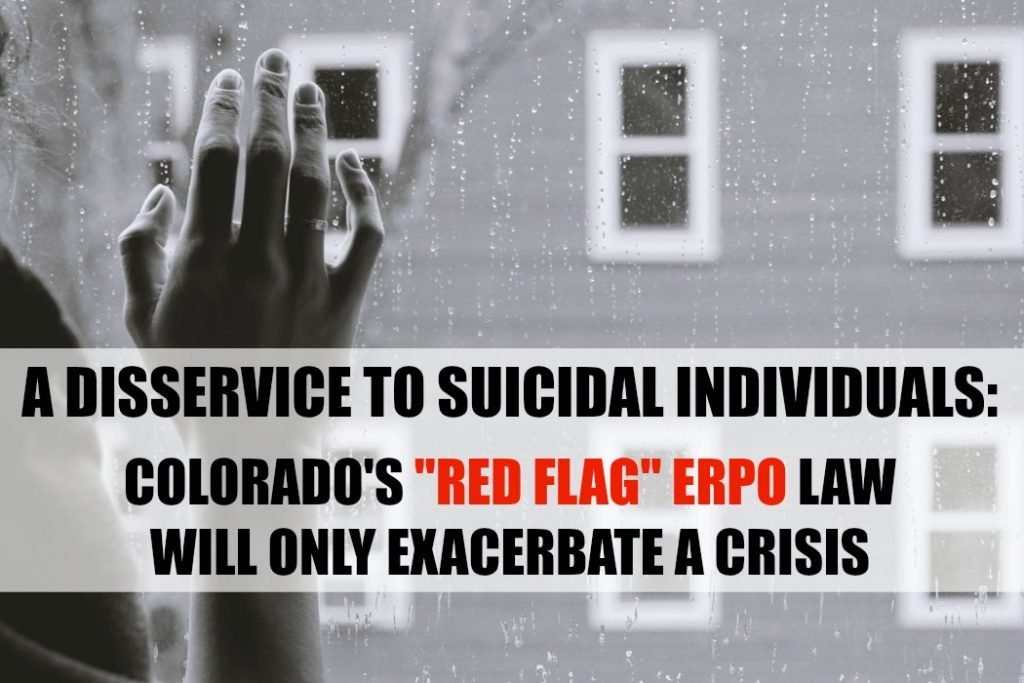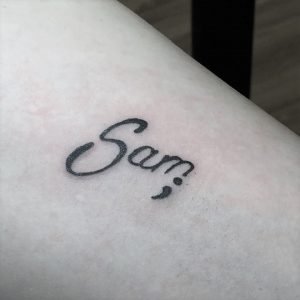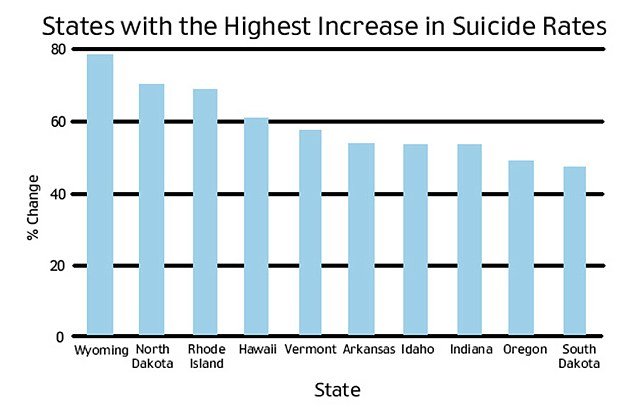
“Red Flag” Extreme Risk Protection Order ERPO laws are picking up steam across the nation. Some states have had them in place for many years, such as Connecticut who implemented theirs in 1999, or Indiana who crafted their law in 2005, and California jumped on the bandwagon in 2014. I’ve written about how ineffective they have been in those states. But the past two years, other states are quickly following suit, including Colorado who passed one of the most egregious laws this past spring. It will go into effect January 1, 2020.
But do they actually help prevent suicide?
States like Indiana pointed to stats showing suicide by firearm was decreasing, but turns out it wasn’t. It was still increasing but not at the projected rate, so they consider that a win. In addition, suicide by other methods has skyrocketed and Indiana has dropped from 19th in the country for mental health in 2011, to 45th in 2015, and in both 2016 and 2017 suicide was the tenth leading cause of death for all residents over all demographics, and the leading cause for certain demographics. Their Red Flag law was enacted in 2005.
Across the country, these laws are being touted as “suicide prevention” by anti-gun groups such as Everytown For Gun Safety and their grassroots arm, Moms Demand Action. Now, these groups have been known to tell half truths, mislead, and fear monger, but their claim that Colorado’s Red Flag law will reduce suicide is one of the most upsetting lies I have heard them tell. That’s because suicide is very near and dear to my heart. My sister committed suicide 4 1/2 years ago.
 My sister was my best friend. She lived one town over, she was the mother to three, and our oldest daughters were born 5 weeks apart. Her suicide rocked my world, and I still shed tears when I think about it. I have her name with a semi-colon tattooed on my arm, my only tattoo. I will never forget the night my mother and my sister came to my home to tell me she was gone, knowing I’d take it harder than anyone else. At first I was in denial as I insisted that she must just be in the hospital, and I needed to get to her. Once past denial, I needed to know where her body was. I got on the phone and desperately started calling people until I connected with the coroner. Her body was in the morgue at a local hospital. I so desperately wanted to be with it. I couldn’t imagine my sister alone in a cold morgue, awaiting autopsy. The next morning was when reality struck. The physical pain I felt in my heart when I awoke was something I had never experienced before and haven’t experience since. Watching her children mourn was heartwrenching. For them everything changed the day she made the choice to take her life. The trajectory of their lives took a sharp, ugly turn. I would do anything to be able to go back and help her that day. But I can’t.
My sister was my best friend. She lived one town over, she was the mother to three, and our oldest daughters were born 5 weeks apart. Her suicide rocked my world, and I still shed tears when I think about it. I have her name with a semi-colon tattooed on my arm, my only tattoo. I will never forget the night my mother and my sister came to my home to tell me she was gone, knowing I’d take it harder than anyone else. At first I was in denial as I insisted that she must just be in the hospital, and I needed to get to her. Once past denial, I needed to know where her body was. I got on the phone and desperately started calling people until I connected with the coroner. Her body was in the morgue at a local hospital. I so desperately wanted to be with it. I couldn’t imagine my sister alone in a cold morgue, awaiting autopsy. The next morning was when reality struck. The physical pain I felt in my heart when I awoke was something I had never experienced before and haven’t experience since. Watching her children mourn was heartwrenching. For them everything changed the day she made the choice to take her life. The trajectory of their lives took a sharp, ugly turn. I would do anything to be able to go back and help her that day. But I can’t.
 My sister didn’t use a firearm to take her life, although she was a gun rights supporting liberal. She used a bottle of pain pills that had been prescribed to her by her doctor.
My sister didn’t use a firearm to take her life, although she was a gun rights supporting liberal. She used a bottle of pain pills that had been prescribed to her by her doctor.
The claims that Colorado’s “Red Flag” ERPO law will help those in a suicidal crisis is disingenuous at best and dangerous at worst. You see, Colorado’s law has no mental health component to it. In fact, Weld County Sheriff Steve Reams has testified to that many times, pointing out that the legislation asks law enforcement to enter the home of a suicidal individual who owns firearms (forcibly if necessary), confiscate those firearms, and leave both the person in crisis and many other tools to follow through with the act of taking their own life.
This is not compassion. This is not empathetic. This is cruel.
There is also strong evidence that when responding to one of these suicidal ERPO’s, law enforcement will arrive with a SWAT team, not only exacerbating the crisis, but escalating it to the point of no return. Early this year, one of our supporters, Ralph Shnelvar, took his own life. He was going through a rough separation and his wife had reported to the police that he was suicidal and had a firearm. Ralph sent worrisome emails to his close friends, who immediately went to his residence to try to offer help. When they arrived, what they found instead was a large police presence and SWAT officers who spent several hours outside the home trying to get Ralph to come out of the residence. Friends and family were blocked from talking to him. Eventually two police robots were sent inside the home where they found Ralph dead. No one can tell me that SWAT did not exacerbate that entire situation, possibly causing and/or expediting the ultimate tragic death.
One of Ralph’s friends testified about this situation in front of a State Senate Committee during the “Red Flag” debate in March. Watch that video below.
This is what Colorado’s “Red Flag” law will look like. SWAT teams going after those who are in crisis, or those who are innocent, another danger we’re facing as the legislation is so poorly written. Here in Colorado a Tinder date turned stalker can petition the courts over the phone free of charge to have someone’s guns confiscated, and the judge who determines if they should do it, will base it off the lowest evidentiary threshold, a preponderance, meaning there only needs to be a 51% chance the accusations are true. Preponderance only requires more evidence than counter evidence, so given that the respondent is not able to respond until after the seizure of the guns no one will ever lose on that standard.
Let’s also talk about the fear these Red Flag laws will create for gun owners, especially veterans. If we fear that reaching out for help will result in SWAT showing up at our house, those who need help will will stay silent, again only increasing suicides, instead of reducing them. We cannot stigmatize asking for help, just as we cannot stigmatize being a gun owner.
What can we do?
Gun owners are compassionate and caring, it’s often why they choose to train and carry in the first place. Because they love their communities. So we should be asking the question what can WE do? Unfortunately there are not a ton of gun owner specific suicide resources, which is unfortunate because it’s desperately needed. But if you are a firearm owner and are suicidal – or someone else in your home is suicidal – there are options. Hold My Guns is a private group who is working to partner with FFL’s and police departments to offer a place people can store firearms during a crisis. There are also multiple suicide prevention hotlines. And recently CU Anschutz unveiled an interactive map that shows out-of-home gun storage facilities for this exact reason. WTTA.org also offers non-crisis support to gun owners.
And then there are the crisis lines:
Veterans Crisis Line: Call 1-800-273-8255 and press 1, text 838255, or chat online
The Right to Keep and Bear Arms must always be defended!
Get a sticker for a donation to Rally for our Rights of $5 or more.
CLICK HERE TO GET YOURS
(other designs available)


